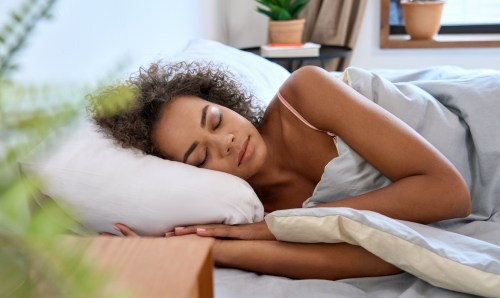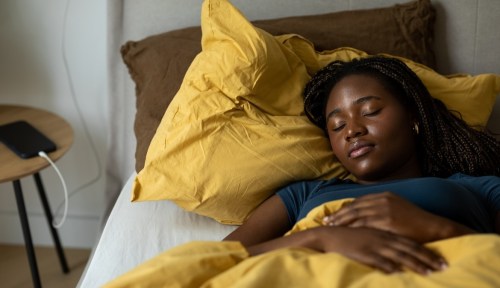Our editors independently select these products. Making a purchase through our links may earn Well+Good a commission
While it’s theoretically lovely to have someone to snuggle up to, co-sleeping with another person can become a living nightmare… especially when snoring is involved. Obviously, though, no one wants the pursuit of a good night’s rest to compromise their relationship, and the prevalence of anti-snoring devices available may be helpful for ensuring the situation never reaches that level of severity.
Experts in This Article
Teofilo Lee-Chiong, MD, pulmonologist and chief medical liaison of sleep and respiratory care for Philips.
What’s key to understand about snoring is that the cacophonous symphony is usually the product of a few body parts—and the sound of the concert (type and volume) can change at different points of any given night. “As we sleep, the roof and walls of our mouth may vibrate during breathing,” says Teofilo Lee-Chiong, MD, pulmonologist and chief medical liaison of sleep and respiratory care for Philips. “The noise generated by these vibrations may intensify as the dimensions of our throat diminish. The nostrils, nasal passages, and tongue can contribute to this noise production. Therefore, the character and volume can vary during the night as well as on different nights. Descriptions of snoring have varied from a low humming to intermittent loud rumbles.”
Dr. Lee-Chiong adds that the narrowing of the upper airways during sleep is a common cause behind new or worsened bouts of snoring. There could also be demographic factors, like a positive family history of snoring or aging at play. Medications can likewise factor in, as can sleep deprivation and sleep position. (He notes that snoring is commonly more severe for people who sleep on their back compared to sleeping on their side.)
Some of those factors can easily be adjusted by human behavior and technological intervention and some can’t. But before before we take a look at different types of anti-snoring devices that can help in either case, let’s distinguish whether a case of snoring may potentially be indicative of a bigger health issue: sleep apnea.
How to know whether snoring is related to sleep apnea
Sleep apnea is a disorder that involves a cessation of breathing that occurs during sleep. With sleep apnea, repetitive reduction of airflow is present due to either partial or complete upper airway occlusion (or blockage) during sleep.
“A person with obstructive sleep apnea has an anatomically narrower and more collapsible upper airway compared to healthy individuals,” says Dr. Lee-Chiong. “During sleep, progressively worsening upper-airway narrowing produces snoring that might eventually lead to a partial or complete closure of the upper airway. Thus snoring, alternating with periods of silence, is a common feature of obstructive sleep apnea.”
If you suspect sleep apnea is at the root of a snoring problem, don’t try any of the following quick-fix gadgets to address it. Instead, please seek the advice of a medical professional. Otherwise, if what you’re encountering on a nightly basis doesn’t sound like sleep apnea, consider trying anti-snoring devices that work by making room for airflow or by suppressing airflow, depending on the snore type. We unpack a few options below that may help you snag a peaceful night of sleep.
7 types of anti-snoring devices for a much smoother snooze
1. Mouth Guard Anti-Snoring Device: SnoreRx, $59 for one, $99 for 2
Mouth guards are a super-popular way to suppress snoring when someone makes a guttural, chesty kind of noise. This model by SnoreRx is an FDA-approved mandibular advancement device (MAD) that addresses your snoring by moving your lower jaw to maintain an open airway. What makes SnoreRx especially notable is its adjustable and thoroughly customizable design. The material creates an impression of your teeth, meaning everything should hold firmly in place. Likewise, the SnoreRx can be altered in one-millimeter increments, so you get that perfect fit.
Shop Now:SnoreRx, $59 for one, $99 for 2
2. Anti-Snoring Nasal Dilators: Snore Care Set of 8 Nasal Dilators, $16
With five stars and a very add-to-cart-worthy price point, these nasal dilators are a low-risk way to test out anti-snoring devices. They work by spreading the nostrils and allowing for a softer inhale-exhale pattern. It comes in a range of sizes and is also available with a travel case, so you can catch some cool vacation zzz’s with no problem at all.
Shop Now:Snore Care Set of 8 Nasal Dilators, $16
3. Vibrating Anti-Snoring Device: Philips – SmartSleep Snoring Relief Band – Gray, $180
The SmartSleep Snoring Relief Band is a high-tech way of making you roll over mid-slumber. And that matters because sleeping on your side may help to mitigate snoring.
The SmartSleep band straps to your chest and gently vibrates when you might be lying on your back. But if you love sleeping starfish style, no worries! It has a built-in 30-minute timer that allows you to fall asleep in your chosen position, and then it urges you to switch it up while you’re dreaming.
Shop Now: Philips – SmartSleep Snoring Relief Band – Gray, $180
4. Chin Strap Anti-Snoring Device: Anti Snoring Chin Strap, $16
I mean, this is certainly a look, if nothing else. The chin strap is meant to keep your jaw delicately clenched as to prevent that whole mouth-breathing genre of snoring. The lightweight style is highly rated, with reviewers noting, at the very least, decent results. While it’s not a beloved-by-all strategy, it might be worth giving a shot if you want try something affordable (and the nose plugs gross you out).
Shop Now:Anti Snoring Chin Strap, $15
5. Anti-Snoring Bumper Belt: SlumberBump Positional Sleep Therapy Belt, $80
This operates with a similar intent as the SmartSleep band, albeit without all the technological trimmings. Instead, the SlumberBump Positional Sleep Therapy Belt is inflatable, and it trains you to sleep on your side with a cute little bumper bag. So, if you were to roll over in the middle of the night while wearing it, you would be weighed down by the pack.
Shop Now: SlumberBump Positional Sleep Therapy Belt, $80
6. Anti-Snoring Nasal Strips: Breathe Right Nasal Strips to Stop Snoring, $26
Is the snoring issue in your life more of an unwelcome irregular visitor than a nightly fixture? If the issue, say, tends to crop up during allergy season or when someone’s coming down with a cold, these nose strips might work well. They pull the nose apart for (you guessed it) a better airflow, and they also help alleviate any congestion. So, definitely stock up on them if sinus challenges coexist with your snoring issue.
Shop Now: Breathe Right Nasal Strips to Stop Snoring, $26
7. Anti-Snoring Wedge Pillow: Sleepnitez Wedge Pillow, $50
Okay, this isn’t so much a “device” as it is a “straight-up pillow to prop someone up.” It’s also a multipurpose sleep solution, because in addition to busting a snoring habit, it claims to be able to aid with tackling issues like heartburn, neck pain, pregnancy discomfort, and other ailments that benefit from a bit of physical support. Once again, though, this wedge is ideal for elevating the neck, promoting side-sleeping, and ultimately cultivating a position that promotes easy airflow.
Shop Now: Sleepnitez Wedge Pillow, $50
Need more tips? Set up some sound barriers
If none of the anti-snoring devices are a worthy fit into your specific situation, there are certainly other ways to deal. A sound barrier can help a snoring problem bother you less, so consider trying on earplugs for size. Look for something with a high Noise Reduction Rate (NRR) of around 32 or 33 decibels. Or you can sound mask the snores by playing something else why you sleep. Think classic white noise, waterfall-mimicking pink noise, or brown noise (which happens to be beloved by team Well+Good).
Ultimately, there might be a little trial and error involved with find which of the anti-snoring devices actually works for you and your life. Since snoring can be a collaborative effort of multiple orifices, if you can first decipher whether the mouth or nose is more troublesome, that’ll help your case for solving the issue. And if no strategy is strong enough to resolve the snoring issues between you and your significant other.? Well, you could always pull an I Love Lucy with separate beds.
Oh hi! You look like someone who loves free workouts, discounts for cult-fave wellness brands, and exclusive Well+Good content. Sign up for Well+, our online community of wellness insiders, and unlock your rewards instantly.
Sign Up for Our Daily Newsletter
Get all the latest in wellness, trends, food, fitness, beauty, and more delivered right to your inbox.
Got it, you've been added to our email list.












